公司理财-罗斯 (第9版) 第14章
- 格式:pdf
- 大小:1.08 MB
- 文档页数:60

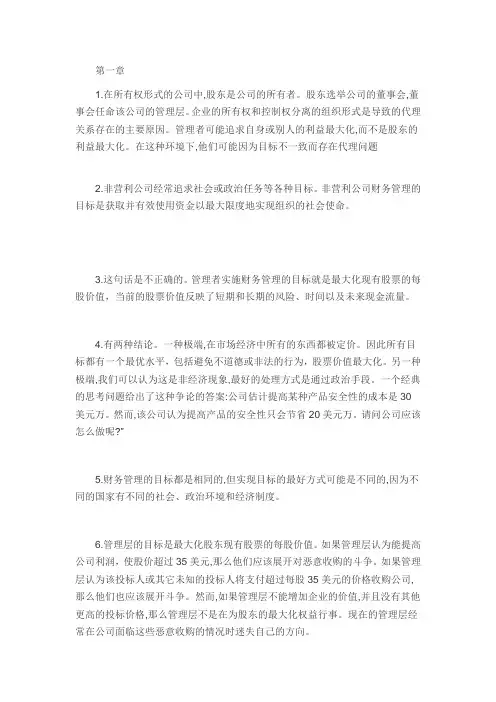
第一章1.在所有权形式的公司中,股东是公司的所有者。
股东选举公司的董事会,董事会任命该公司的管理层。
企业的所有权和控制权分离的组织形式是导致的代理关系存在的主要原因。
管理者可能追求自身或别人的利益最大化,而不是股东的利益最大化。
在这种环境下,他们可能因为目标不一致而存在代理问题2.非营利公司经常追求社会或政治任务等各种目标。
非营利公司财务管理的目标是获取并有效使用资金以最大限度地实现组织的社会使命。
3.这句话是不正确的。
管理者实施财务管理的目标就是最大化现有股票的每股价值,当前的股票价值反映了短期和长期的风险、时间以及未来现金流量。
4.有两种结论。
一种极端,在市场经济中所有的东西都被定价。
因此所有目标都有一个最优水平,包括避免不道德或非法的行为,股票价值最大化。
另一种极端,我们可以认为这是非经济现象,最好的处理方式是通过政治手段。
一个经典的思考问题给出了这种争论的答案:公司估计提高某种产品安全性的成本是30美元万。
然而,该公司认为提高产品的安全性只会节省20美元万。
请问公司应该怎么做呢?”5.财务管理的目标都是相同的,但实现目标的最好方式可能是不同的,因为不同的国家有不同的社会、政治环境和经济制度。
6.管理层的目标是最大化股东现有股票的每股价值。
如果管理层认为能提高公司利润,使股价超过35美元,那么他们应该展开对恶意收购的斗争。
如果管理层认为该投标人或其它未知的投标人将支付超过每股35美元的价格收购公司,那么他们也应该展开斗争。
然而,如果管理层不能增加企业的价值,并且没有其他更高的投标价格,那么管理层不是在为股东的最大化权益行事。
现在的管理层经常在公司面临这些恶意收购的情况时迷失自己的方向。
7.其他国家的代理问题并不严重,主要取决于其他国家的私人投资者占比重较小。
较少的私人投资者能减少不同的企业目标。
高比重的机构所有权导致高学历的股东和管理层讨论决策风险项目。
此外,机构投资者比私人投资者可以根据自己的资源和经验更好地对管理层实施有效的监督机制。
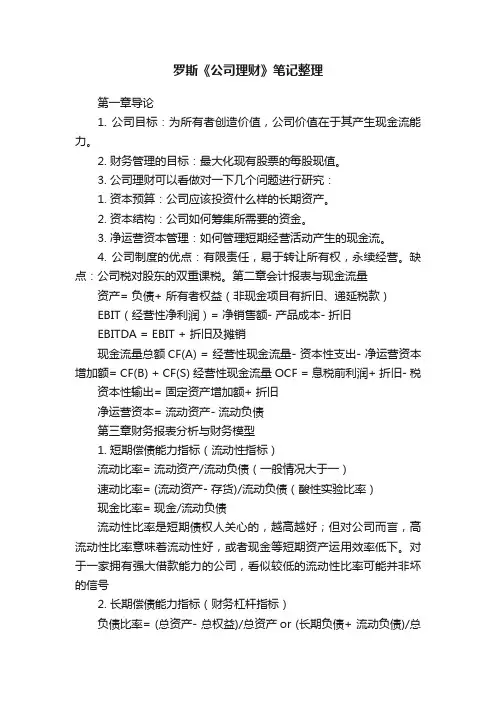
罗斯《公司理财》笔记整理第一章导论1. 公司目标:为所有者创造价值,公司价值在于其产生现金流能力。
2. 财务管理的目标:最大化现有股票的每股现值。
3. 公司理财可以看做对一下几个问题进行研究:1. 资本预算:公司应该投资什么样的长期资产。
2. 资本结构:公司如何筹集所需要的资金。
3. 净运营资本管理:如何管理短期经营活动产生的现金流。
4. 公司制度的优点:有限责任,易于转让所有权,永续经营。
缺点:公司税对股东的双重课税。
第二章会计报表与现金流量资产= 负债+ 所有者权益(非现金项目有折旧、递延税款)EBIT(经营性净利润)= 净销售额- 产品成本- 折旧EBITDA = EBIT + 折旧及摊销现金流量总额CF(A) = 经营性现金流量- 资本性支出- 净运营资本增加额= CF(B) + CF(S) 经营性现金流量OCF = 息税前利润+ 折旧- 税资本性输出= 固定资产增加额+ 折旧净运营资本= 流动资产- 流动负债第三章财务报表分析与财务模型1. 短期偿债能力指标(流动性指标)流动比率= 流动资产/流动负债(一般情况大于一)速动比率= (流动资产- 存货)/流动负债(酸性实验比率)现金比率= 现金/流动负债流动性比率是短期债权人关心的,越高越好;但对公司而言,高流动性比率意味着流动性好,或者现金等短期资产运用效率低下。
对于一家拥有强大借款能力的公司,看似较低的流动性比率可能并非坏的信号2. 长期偿债能力指标(财务杠杆指标)负债比率= (总资产- 总权益)/总资产or (长期负债+ 流动负债)/总资产权益乘数= 总资产/总权益= 1 + 负债权益比利息倍数= EBIT/利息现金对利息的保障倍数(Cash coverage radio) = EBITDA/利息3. 资产管理或资金周转指标存货周转率= 产品销售成本/存货存货周转天数= 365天/存货周转率应收账款周转率= (赊)销售额/应收账款总资产周转率= 销售额/总资产= 1/资本密集度4. 盈利性指标销售利润率= 净利润/销售额资产收益率ROA = 净利润/总资产权益收益率ROE = 净利润/总权益5. 市场价值度量指标市盈率= 每股价格/每股收益EPS 其中EPS = 净利润/发行股票数市值面值比= 每股市场价值/每股账面价值企业价值EV = 公司市值+ 有息负债市值- 现金EV乘数= EV/EBITDA6. 杜邦恒等式ROE = 销售利润率(经营效率)x总资产周转率(资产运用效率)x权益乘数(财杠)ROA = 销售利润率x总资产周转率7. 销售百分比法假设项目随销售额变动而成比例变动,目的在于提出一个生成预测财务报表的快速实用方法。
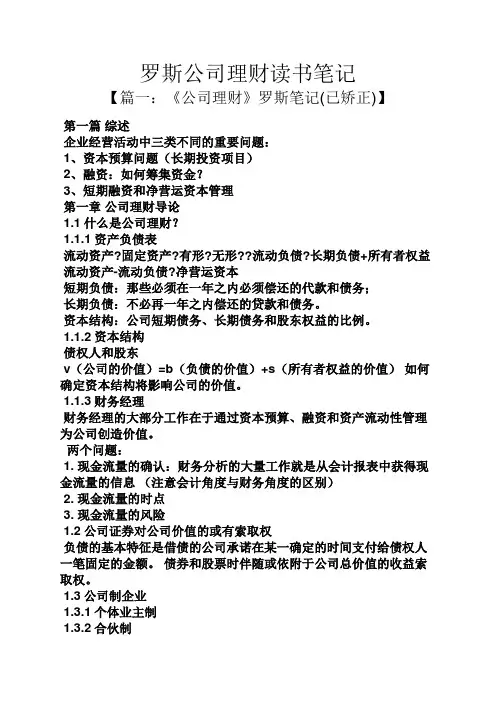
罗斯公司理财读书笔记【篇一:《公司理财》罗斯笔记(已矫正)】第一篇综述企业经营活动中三类不同的重要问题:1、资本预算问题(长期投资项目)2、融资:如何筹集资金?3、短期融资和净营运资本管理第一章公司理财导论1.1什么是公司理财?1.1.1资产负债表流动资产?固定资产?有形?无形??流动负债?长期负债+所有者权益流动资产-流动负债?净营运资本短期负债:那些必须在一年之内必须偿还的代款和债务;长期负债:不必再一年之内偿还的贷款和债务。
资本结构:公司短期债务、长期债务和股东权益的比例。
1.1.2资本结构债权人和股东v(公司的价值)=b(负债的价值)+s(所有者权益的价值)如何确定资本结构将影响公司的价值。
1.1.3财务经理财务经理的大部分工作在于通过资本预算、融资和资产流动性管理为公司创造价值。
两个问题:1. 现金流量的确认:财务分析的大量工作就是从会计报表中获得现金流量的信息(注意会计角度与财务角度的区别)2. 现金流量的时点3. 现金流量的风险1.2公司证券对公司价值的或有索取权负债的基本特征是借债的公司承诺在某一确定的时间支付给债权人一笔固定的金额。
债券和股票时伴随或依附于公司总价值的收益索取权。
1.3公司制企业1.3.1个体业主制1.3.2合伙制1.3.3公司制有限责任、产权易于转让和永续经营是其主要优点。
1.4公司制企业的目标公司制企业力图通过采取行动提高现有公司股票的价值以使股东财富最大化。
1.4.1代理成本和系列契约理论的观点代理成本:股东的监督成本和实施控制的成本1.4.2管理者的目标管理者的目标可能不同于股东的目标。
donaldson提出的管理者的两大动机:①②(组织的)生存;独立性和自我满足。
1.4.3所有权和控制权的分离——谁在经营企业?1.4.4股东应控制管理者行为吗?促使股东可以控制管理者的因素:①②③④股东通过股东大会选举董事;报酬计划和业绩激励计划;被接管的危险;经理市场的激烈竞争。

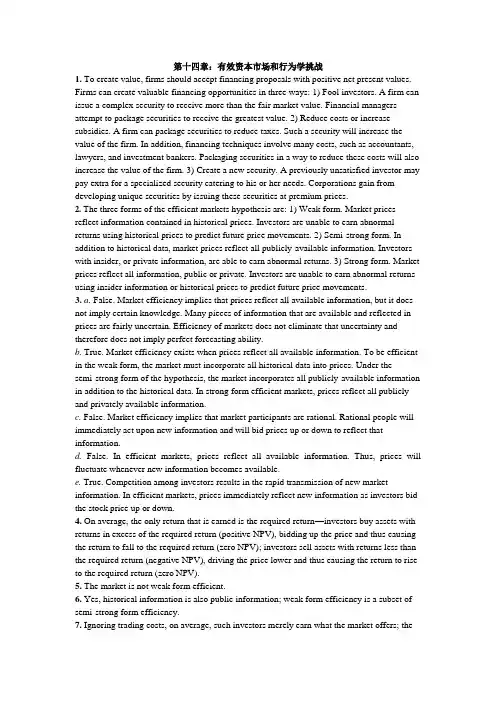
第十四章:有效资本市场和行为学挑战1. To create value, firms should accept financing proposals with positive net present values. Firms can create valuable financing opportunities in three ways: 1) Fool investors. A firm can issue a complex security to receive more than the fair market value. Financial managers attempt to package securities to receive the greatest value. 2) Reduce costs or increase subsidies. A firm can package securities to reduce taxes. Such a security will increase the value of the firm. In addition, financing techniques involve many costs, such as accountants, lawyers, and investment bankers. Packaging securities in a way to reduce these costs will also increase the value of the firm. 3) Create a new security. A previously unsatisfied investor may pay extra for a specialized security catering to his or her needs. Corporations gain from developing unique securities by issuing these securities at premium prices.2. The three forms of the efficient markets hypothesis are: 1) Weak form. Market prices reflect information contained in historical prices. Investors are unable to earn abnormal returns using historical prices to predict future price movements. 2) Semi-strong form. In addition to historical data, market prices reflect all publicly-available information. Investors with insider, or private information, are able to earn abnormal returns. 3) Strong form. Market prices reflect all information, public or private. Investors are unable to earn abnormal returns using insider information or historical prices to predict future price movements.3. a. False. Market efficiency implies that prices reflect all available information, but it does not imply certain knowledge. Many pieces of information that are available and reflected in prices are fairly uncertain. Efficiency of markets does not eliminate that uncertainty and therefore does not imply perfect forecasting ability.b. True. Market efficiency exists when prices reflect all available information. To be efficient in the weak form, the market must incorporate all historical data into prices. Under thesemi-strong form of the hypothesis, the market incorporates all publicly-available information in addition to the historical data. In strong form efficient markets, prices reflect all publicly and privately available information.c. False. Market efficiency implies that market participants are rational. Rational people will immediately act upon new information and will bid prices up or down to reflect that information.d. False. In efficient markets, prices reflect all available information. Thus, prices will fluctuate whenever new information becomes available.e. True. Competition among investors results in the rapid transmission of new market information. In efficient markets, prices immediately reflect new information as investors bid the stock price up or down.4. On average, the only return that is earned is the required return—investors buy assets with returns in excess of the required return (positive NPV), bidding up the price and thus causing the return to fall to the required return (zero NPV); investors sell assets with returns less than the required return (negative NPV), driving the price lower and thus causing the return to rise to the required return (zero NPV).5. The market is not weak form efficient.6. Yes, historical information is also public information; weak form efficiency is a subset of semi-strong form efficiency.7. Ignoring trading costs, on average, such investors merely earn what the market offers; thetrades all have zero NPV. If trading costs exist, then these investors lose by the amount of the costs.8. Unlike gambling, the stock market is a positive sum game; everybody can win. Also, speculators provide liquidity to markets and thus help to promote efficiency.9. The EMH only says, within the bounds of increasingly strong assumptions about the information processing of investors, that assets are fairly priced. An implication of this is that, on average, the typical market participant cannot earn excessive profits from a particular trading strategy. However, that does not mean that a few particular investors cannot outperform the market over a particular investment horizon. Certain investors who do well for a period of time get a lot of attention from the financial press, but the scores of investors who do not do well over the same period of time generally get considerably less attention from the financial press.10. a. If the market is not weak form efficient, then this information could be acted on and a profit earned from following the price trend. Under (2), (3), and (4), this information is fully impounded in the current price and no abnormal profit opportunity exists.b. Under (2), if the market is not semi-strong form efficient, then this information could be used to buy the stock ―cheap‖before the rest of the market discovers the financial statement anomaly. Since (2) is stronger than (1), both imply that a profit opportunity exists; under (3) and (4), this information is fully impounded in the current price and no profit opportunity exists.c. Under (3), if the market is not strong form efficient, then this information could be used as a profitable trading strategy, by noting the buying activity of the insiders as a signal that the stock is underpriced or that good news is imminent. Since (1) and (2) are weaker than (3), all three imply that a profit opportunity exists. Note that this assumes the individual who sees the insider trading is the only one who sees the trading. If the information about the trades made by company management is public information, it will be discounted in the stock price and no profit opportunity exists. Under (4), this information does not signal any profit opportunity for traders; any pertinent information the manager-insiders may have is fully reflected in the current share price.11. A technical analyst would argue that the market is not efficient. Since a technical analyst examines past prices, the market cannot be weak form efficient for technical analysis to work. If the market is not weak form efficient, it cannot be efficient under stronger assumptions about the information available.12. Investor sentiment captures the mood of the investing public. If investors are bearish in general, it may be that the market is headed down in the future since investors are less likely to invest. If the sentiment is bullish, it would be taken as a positive signal to the market. To use investor sentiment in technical analysis, you would probably want to construct a ratio such as a bulls/bears ratio. To use the ratio, simply compare the historical ratio to the market to determine if a certain level on the ratio indicates a market upturn or downturn. Of course, there is a group of investors called contrarians who view the market signals as reversed. That is, if the number of bearish investors reaches a certain level, the market will head up. For a contrarian, these signals are reversed.13. Taken at face value, this fact suggests that markets have become more efficient. The increasing ease with which information is available over the Internet lends strength to thisconclusion. On the other hand, during this particular period, large-capitalization growth stocks were the top performers. Value-weighted indexes such as the S&P 500 are naturally concentrated in such stocks, thus making them especially hard to beat during this period. So, it may be that the dismal record compiled by the pros is just a matter of bad luck or benchmark error.14. It is likely the market has a better estimate of the stock price, assuming it is semistrong form efficient. However, semistrong form efficiency only states that you cannot easily profit from publicly available information. If financial statements are not available, the market can still price stocks based upon the available public information, limited though it may be. Therefore, it may have been as difficult to examine the limited public information and make an extra return.15. a. Aerotech‘s stock price should rise immediately after the announcement of the positive news.b. Only scenario (ii) indicates market efficiency. In that case, the price of the stock rises immediately to the level that reflects the new information, eliminating all possibility of abnormal returns. In the other two scenarios, there are periods of time during which an investor could trade on the information and earn abnormal returns.16. False. The stock price would have adjusted before the founder‘s death only if investors had perfect forecasting ability. The 12.5 percent increase in the stock price aft er the founder‘s death indicates that either the market did not anticipate the death or that the market had anticipated it imperfectly. However, the market reacted immediately to the new information, implying efficiency. It is interesting that the stock price rose after the announcement of the founder‘s death. This price behavior indicates that the market felt he was a liability to the firm.17. The announcement should not deter investors from buying UPC‘s stock. If the market is semi-strong form efficient, the stock price will have already reflected the present value of the payments that UPC must make. The expected return after the announcement should still be equal to the expected return before the announcement. UPC‘s current stockholders bear the burden of the loss, since the stock price falls on the announcement. After the announcement, the expected return moves back to its original level.18. The market is often considered to be relatively efficient up to the semi-strong form. If so, no systematic profit can be made by trading on publicly-available information. Although illegal, the lead engineer of the device can profit from purchasing the firm‘s stock before the news release on the implementation of the new technology. The price should immediately and fully adjust to the new information in the article. Thus, no abnormal return can be expected from purchasing after the publication of the article.19. Under the semi-strong form of market efficiency, the stock price should stay the same. The accounting system changes are publicly available information. Investors would identify no changes in either the firm‘s current or its future cash flows. Thus, the stock price will not change after the announcement of increased earnings.20. Because the number of subscribers has increased dramatically, the time it takes for information in the newsletter to be reflected in prices has shortened. With shorter adjustment periods, it becomes impossible to earn abnormal returns with the information provided by Durkin. If Durkin is using only publicly-available information in its newsletter, its ability topick stocks is inconsistent with the efficient markets hypothesis. Under the semi-strong form of market efficiency, all publicly-available information should be reflected in stock prices. The use of private information for trading purposes is illegal.21. You should not agree with your broker. The performance ratings of the small manufacturing firms were published and became public information. Prices should adjust immediately to the information, thus preventing future abnormal returns.22. Stock prices should immediately and fully rise to reflect the announcement. Thus, one cannot expect abnormal returns following the announcement.23. a. No. Earnings information is in the public domain and reflected in the current stock price.b. Possibly. If the rumors were publicly disseminated, the prices would have already adjusted for the possibility of a merger. If the rumor is information that you received from an insider, you could earn excess returns, although trading on that information is illegal.c. No. The information is already public, and thus, already reflected in the stock price.24. Serial correlation occurs when the current value of a variable is related to the future value of the variable. If the market is efficient, the information about the serial correlation in the macroeconomic variable and its relationship to net earnings should already be reflected in the stock price. In other words, although there is serial correlation in the variable, there will not be serial correlation in stock returns. Therefore, knowledge of the correlation in the macroeconomic variable will not lead to abnormal returns for investors.25. The statement is false because every investor has a different risk preference. Although the expected return from every well-diversified portfolio is the same after adjusting for risk, investors still need to choose funds that are consistent with their particular risk level.26. The share price will decrease immediately to reflect the new information. At the time of the announcement, the price of the stock should immediately decrease to reflect the negative information.27. In an efficient market, the cumulative abnormal return (CAR) for Prospectors would rise substantially at the announcement of a new discovery. The CAR falls slightly on any day when no discovery is announced. There is a small positive probability that there will be a discovery on any given day. If there is no discovery on a particular day, the price should fall slightly because the good event did not occur. The substantial price increases on the rare days of discovery should balance the small declines on the other days, leaving CARs that are horizontal over time.28. Behavioral finance attempts to explain both the 1987 stock market crash and the Internet bubble by changes in investor sentiment and psychology. These changes can lead to non-random price behavior.。

第一章1.在所有权形式的公司中,股东是公司的所有者。
股东选举公司的董事会,董事会任命该公司的管理层。
企业的所有权和控制权分离的组织形式是导致的代理关系存在的主要原因。
管理者可能追求自身或别人的利益最大化,而不是股东的利益最大化。
在这种环境下,他们可能因为目标不一致而存在代理问题2.非营利公司经常追求社会或政治任务等各种目标。
非营利公司财务管理的目标是获取并有效使用资金以最大限度地实现组织的社会使命。
3.这句话是不正确的。
管理者实施财务管理的目标就是最大化现有股票的每股价值,当前的股票价值反映了短期和长期的风险、时间以及未来现金流量。
4.有两种结论。
一种极端,在市场经济中所有的东西都被定价。
因此所有目标都有一个最优水平,包括避免不道德或非法的行为,股票价值最大化。
另一种极端,我们可以认为这是非经济现象,最好的处理方式是通过政治手段。
一个经典的思考问题给出了这种争论的答案:公司估计提高某种产品安全性的成本是30美元万。
然而,该公司认为提高产品的安全性只会节省20美元万。
请问公司应该怎么做呢?”5.财务管理的目标都是相同的,但实现目标的最好方式可能是不同的,因为不同的国家有不同的社会、政治环境和经济制度。
6.管理层的目标是最大化股东现有股票的每股价值。
如果管理层认为能提高公司利润,使股价超过35美元,那么他们应该展开对恶意收购的斗争。
如果管理层认为该投标人或其它未知的投标人将支付超过每股35美元的价格收购公司,那么他们也应该展开斗争。
然而,如果管理层不能增加企业的价值,并且没有其他更高的投标价格,那么管理层不是在为股东的最大化权益行事。
现在的管理层经常在公司面临这些恶意收购的情况时迷失自己的方向。
7.其他国家的代理问题并不严重,主要取决于其他国家的私人投资者占比重较小。
较少的私人投资者能减少不同的企业目标。
高比重的机构所有权导致高学历的股东和管理层讨论决策风险项目。
此外,机构投资者比私人投资者可以根据自己的资源和经验更好地对管理层实施有效的监督机制。

第一章1.在所有权形式的公司中,股东是公司的所有者。
股东选举公司的董事会,董事会任命该公司的管理层。
企业的所有权和控制权分离的组织形式是导致的代理关系存在的主要原因。
管理者可能追求自身或别人的利益最大化,而不是股东的利益最大化。
在这种环境下,他们可能因为目标不一致而存在代理问题2.非营利公司经常追求社会或政治任务等各种目标。
非营利公司财务管理的目标是获取并有效使用资金以最大限度地实现组织的社会使命。
3.这句话是不正确的。
管理者实施财务管理的目标就是最大化现有股票的每股价值,当前的股票价值反映了短期和长期的风险、时间以及未来现金流量。
4.有两种结论。
一种极端,在市场经济中所有的东西都被定价。
因此所有目标都有一个最优水平,包括避免不道德或非法的行为,股票价值最大化。
另一种极端,我们可以认为这是非经济现象,最好的处理方式是通过政治手段。
一个经典的思考问题给出了这种争论的答案:公司估计提高某种产品安全性的成本是30美元万。
然而,该公司认为提高产品的安全性只会节省20美元万。
请问公司应该怎么做呢?”5.财务管理的目标都是相同的,但实现目标的最好方式可能是不同的,因为不同的国家有不同的社会、政治环境和经济制度。
6.管理层的目标是最大化股东现有股票的每股价值。
如果管理层认为能提高公司利润,使股价超过35美元,那么他们应该展开对恶意收购的斗争。
如果管理层认为该投标人或其它未知的投标人将支付超过每股35美元的价格收购公司,那么他们也应该展开斗争。
然而,如果管理层不能增加企业的价值,并且没有其他更高的投标价格,那么管理层不是在为股东的最大化权益行事。
现在的管理层经常在公司面临这些恶意收购的情况时迷失自己的方向。
7.其他国家的代理问题并不严重,主要取决于其他国家的私人投资者占比重较小。
较少的私人投资者能减少不同的企业目标。
高比重的机构所有权导致高学历的股东和管理层讨论决策风险项目。
此外,机构投资者比私人投资者可以根据自己的资源和经验更好地对管理层实施有效的监督机制。


(完整版)公司理财-罗斯课后习题答案-CAL-FENGHAI-(2020YEAR-YICAI)_JINGBIAN第一章1.在所有权形式的公司中,股东是公司的所有者。
股东选举公司的董事会,董事会任命该公司的管理层。
企业的所有权和控制权分离的组织形式是导致的代理关系存在的主要原因。
管理者可能追求自身或别人的利益最大化,而不是股东的利益最大化。
在这种环境下,他们可能因为目标不一致而存在代理问题。
2.非营利公司经常追求社会或政治任务等各种目标。
非营利公司财务管理的目标是获取并有效使用资金以最大限度地实现组织的社会使命。
3.这句话是不正确的。
管理者实施财务管理的目标就是最大化现有股票的每股价值,当前的股票价值反映了短期和长期的风险、时间以及未来现金流量。
4.有两种结论。
一种极端,在市场经济中所有的东西都被定价。
因此所有目标都有一个最优水平,包括避免不道德或非法的行为,股票价值最大化。
另一种极端,我们可以认为这是非经济现象,最好的处理方式是通过政治手段。
一个经典的思考问题给出了这种争论的答案:公司估计提高某种产品安全性的成本是30美元万。
然而,该公司认为提高产品的安全性只会节省20美元万。
请问公司应该怎么做呢?”5.财务管理的目标都是相同的,但实现目标的最好方式可能是不同的,因为不同的国家有不同的社会、政治环境和经济制度。
6.管理层的目标是最大化股东现有股票的每股价值。
如果管理层认为能提高公司利润,使股价超过35美元,那么他们应该展开对恶意收购的斗争。
如果管理层认为该投标人或其它未知的投标人将支付超过每股35美元的价格收购公司,那么他们也应该展开斗争。
然而,如果管理层不能增加企业的价值,并且没有其他更高的投标价格,那么管理层不是在为股东的最大化权益行事。
现在的管理层经常在公司面临这些恶意收购的情况时迷失自己的方向。
7.其他国家的代理问题并不严重,主要取决于其他国家的私人投资者占比重较小。
较少的私人投资者能减少不同的企业目标。
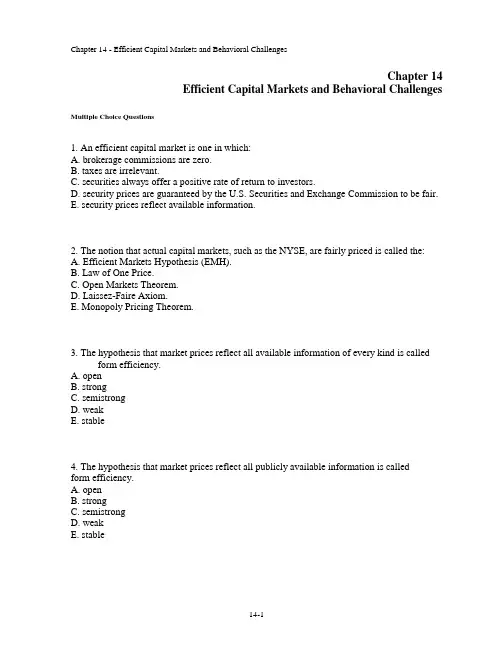
Chapter 14Efficient Capital Markets and Behavioral Challenges Multiple Choice Questions1. An efficient capital market is one in which:A. brokerage commissions are zero.B. taxes are irrelevant.C. securities always offer a positive rate of return to investors.D. security prices are guaranteed by the U.S. Securities and Exchange Commission to be fair.E. security prices reflect available information.2. The notion that actual capital markets, such as the NYSE, are fairly priced is called the:A. Efficient Markets Hypothesis (EMH).B. Law of One Price.C. Open Markets Theorem.D. Laissez-Faire Axiom.E. Monopoly Pricing Theorem.3. The hypothesis that market prices reflect all available information of every kind is called_____ form efficiency.A. openB. strongC. semistrongD. weakE. stable4. The hypothesis that market prices reflect all publicly available information is called _____ form efficiency.A. openB. strongC. semistrongD. weakE. stable5. The hypothesis that market prices reflect all historical information is called _____ form efficiency.A. openB. strongC. semistrongD. weakE. stable6. In an efficient market, the price of a security will:A. always rise immediately upon the release of new information with no further price adjustments related to that information.B. react to new information over a two-day period after which time no further price adjustments related to that information will occur.C. rise sharply when new information is first released and then decline to a new stable level by the following day.D. react immediately to new information with no further price adjustments related to that information.E. be slow to react for the first few hours after new information is released allowing time for that information to be reviewed and analyzed.7. If the financial markets are efficient, then investors should expect their investments in those markets to:A. earn extraordinary returns on a routine basis.B. generally have positive net present values.C. generally have zero net present values.D. produce arbitrage opportunities on a routine basis.E. produce negative returns on a routine basis.8. Which one of the following statements is correct concerning market efficiency?A. Real asset markets are more efficient than financial markets.B. If a market is efficient, arbitrage opportunities should be common.C. In an efficient market, some market participants will have an advantage over others.D. A firm will generally receive a fair price when it sells shares of stock.E. New information will gradually be reflected in a stock's price to avoid any sudden change in the price of the stock.9. According to the efficient market hypothesis, financial markets fluctuate daily because they:A. are inefficient.B. slowly react to new information.C. are continually reacting to new information.D. offer tremendous arbitrage opportunities.E. only reflect historical information.10. Insider trading does not offer any advantages if the financial markets are:A. weak form efficient.B. semiweak form efficient.C. semistrong form efficient.D. strong form efficient.E. inefficient.11. According to theory, studying historical prices in order to identify mispriced stocks will not work in markets that are _____ efficient.I. weak formII. semistrong formIII. strong formA. I onlyB. II onlyC. I and II onlyD. II and III onlyE. I, II, and III12. Which of the following tend to reinforce the argument that the financial markets are efficient?I. Information spreads rapidly in today's world.II. There is tremendous competition in the financial markets.III. Market prices continually fluctuate.IV. Market prices react suddenly to unexpected news announcements.A. I and III onlyB. II and IV onlyC. I, II, and III onlyD. II, III, and IV onlyE. I, II, III, and IV13. If you excel in analyzing the future outlook of firms, you would prefer that the financial markets be ____ form efficient so that you can have an advantage in the marketplace.A. weakB. semiweakC. semistrongD. strongE. perfect14. Your best friend works in the finance office of the Delta Corporation. You are aware that this friend trades Delta stock based on information he overhears in the office. You know that this information is not known to the general public. Your friend continually brags to you about the profits he earns trading Delta stock. Based on this information, you would tend to argue that the financial markets are at best _____ form efficient.A. weakB. semiweakC. semistrongD. strongE. perfect15. The U.S. Securities and Exchange Commission periodically charges individuals for insider trading and claims those individuals have made unfair profits. Based on this fact, you would tend to argue that the financial markets are at best _____ form efficient.A. weakB. semiweakC. semistrongD. strongE. perfect16. Individuals that continually monitor the financial markets seeking mispriced securities:A. tend to make substantial profits on a daily basis.B. tend to make the markets more efficient.C. are never able to find a security that is temporarily mispriced.D. are always quite successful using only well-known public information as their basis of evaluation.E. are always quite successful using only historical price information as their basis of evaluation.17. Efficient capital markets are financial markets:A. in which current market prices reflect available information.B. in which current market prices reflect the present value of securities.C. in which there is no excess profit from using available information.D. All of the above.E. None of the above.18. If the efficient market hypothesis holds, investors should expect:A. to earn only a normal return.B. to receive a fair price for their securities.C. to always be able to pick stocks that will outperform the market averages.D. Both A and B.E. Both B and C.19. Financial managers can create value through financing decisions that:A. reduce costs or increase subsidies.B. increase the product prices.C. create a new security.D. Both A and B.E. Both A and C.20. In an efficient market when a firm makes an announcement of a new product or product enhancement with superior technology providing positive NPV, the price of the stock will:A. rise gradually over the next few days.B. decline gradually over the next few days.C. rise on the same day to the new price.D. stay at the same price, with no net effect.E. drop on the same day to the new price.21. An investor discovers that for a certain group of stocks, large positive price changes are always followed by large negative price changes. This finding is a violation of the:A. moderate form of the efficient market hypothesis.B. semistrong form of the efficient market hypothesis.C. strong form of the efficient market hypothesis.D. weak form of the efficient market hypothesis.E. None of the above.22. Which of the following would be indicative of inefficient markets?A. Overreaction and reversionB. Delayed responseC. Immediate and accurate responseD. Both A and B.E. Both A and C.23. When the stock price follows a random walk, the price today is said to be equal to the prior period price plus the expected return for the period with any remaining difference to the actual return due to:A. a predictable amount based on the past prices.B. a component based on new information unrelated to past prices.C. the security's risk.D. the risk free rate.E. None of the above.24. Which form of the efficient market hypothesis implies that security prices reflect only information contained in past prices?A. Weak formB. Semistrong formC. Strong formD. Hard formE. Past form25. If the weak form of efficient markets holds, then:A. technical analysis is useless.B. stock prices reflect all information contained in past prices.C. stock prices follow a random walk.D. All of the above.E. None of the above.26. Under the concept of an efficient market, a random walk in stock prices means that:A. there is no driving force behind price changes.B. technical analysts can predict future price movements to earn excess returns.C. the unexplained portion of price change in one period is unrelated to the unexplained portion of price change in any other period.D. the unexplained portion of price change in one period that can not be explained by expected return can only be explained by the unexplained portion of price change in a prior period.E. None of the above.27. A semistrong form efficient market is distinct from a weak form efficient market by:A. incorporating only random movements in the price.B. incorporating all publicly available information in the price.C. incorporating inside information in the price.D. All of the above.E. None of the above.28. If a market is strong form efficient, it also implies that:A. semistrong form efficiency holds.B. weak form efficiency holds.C. one cannot earn abnormal returns with inside information.D. Both A and C.E. A, B and C.29. An investor discovers that predictions about weather patterns published years in advance and found in the Farmer's Almanac are amazingly accurate. In fact, these predictions enable the investor to predict the health of the farm economy and therefore certain security prices. This finding is a violation of the:A. moderate form of the efficient market hypothesis.B. semistrong form of the efficient market hypothesis.C. strong form of the efficient market hypothesis.D. weak form of the efficient market hypothesis.E. None of the above.30. A lawyer works for a firm that advises corporate firms planning to sue other corporations for antitrust damages. He finds that he can "beat the market" by short-selling the stock of the firm that will be sued. This finding is a violation of the:A. moderate form of the efficient market hypothesis.B. semistrong form of the efficient market hypothesis.C. strong form of the efficient market hypothesis.D. weak form of the efficient market hypothesis.E. None of the above.31. An investor discovers that stock prices change drastically as a result of certain events. This finding is a violation of the:A. moderate form of the efficient market hypothesis.B. semistrong form of the efficient market hypothesis.C. strong form of the efficient market hypothesis.D. weak form of the efficient market hypothesis.E. None of the above.32. The semistrong form of the efficient market hypothesis states that:A. all information is reflected in the price of securities.B. security prices reflect all publicly available information.C. future prices are predictable.D. Both A and C.E. None of the above.33. The market price of a stock moves or fluctuates daily. This fluctuation is:A. inconsistent with the semistrong efficient market hypothesis because prices should be stable.B. inconsistent with the weak form efficient market hypothesis because all past information should be priced in.C. consistent with the semistrong form of the efficient market hypothesis because as new information arrives daily prices will adjust to it.D. consistent with the strong form because prices are controlled by insiders.E. None of the above.34. An investor who picks a portfolio by throwing darts at the financial pages:A. believes that efficient markets will protect the portfolio from harm as all information is priced.B. believes that riskier portfolios earn the same as less risky portfolios.C. does so because stock prices do not matter; only cash flow generated matters.D. Both A and C.E. Both B and C.35. Suppose that firms with unexpectedly high earnings earn abnormally high returns for several months after the announcement. This would be evidence of:A. efficient markets in the weak form.B. inefficient markets in the weak form.C. efficient markets in the semistrong form.D. inefficient markets in the semistrong form.E. inefficient markets in the strong form.36. Which of the following is not true about serial correlation?A. It measures the correlation between the current return on a security and the current return on another security.B. It involves only one security.C. Positive serial correlation indicates a tendency for continuation.D. Negative serial correlation indicates a tendency toward reversal.E. Significant positive or negative serial correlation coefficients are indicative of market inefficiency in the weak form.37. Which of the following is true?A. A random walk for stock price changes is inconsistent with observed patterns in price changes.B. If the stock market follows a random walk, price changes should be highly correlated.C. If the stock market is weak form efficient, then stock prices follow a random walk.D. All of the above.E. Both B and C.38. Event studies attempt to measure:A. the influence of information released to the market on returns in days surrounding its announcement.B. if the market is at least semistrong form efficient.C. whether there is a significant reaction to public announcements.D. All of the above.E. None of the above.39. The abnormal return in an event study is described as:A. the return earned on the day of announcement for the stock.B. the excess return earned on the day of announcement for the stock.C. the total return earned for the investment holding period.D. All of the above.E. None of the above.40. Evidence on stock prices finds that the sudden death of a chief executive officer causes stock prices to fall and the sudden death of an active founding chief executive officer causes stock price to rise. This contrary evidence happens because:A. markets are inefficient and unsure of the real value of the events.B. death is inevitable and market prices are random.C. things simply happen.D. the value of the founding executive was a negative to the firm.E. None of the above.41. Studies of the performance of professionally managed mutual funds find that these funds:A. do not outperform a market index. Assuming mutual fund managers rely primarily on public information, this finding refutes the semistrong form of the efficient market hypothesis.B. do not outperform a market index. Assuming mutual fund managers rely primarily on public information, this finding supports the semistrong form of the efficient market hypothesis.C. outperform a market index. Assuming mutual fund managers rely primarily on public information, this finding refutes the semistrong form of the efficient market hypothesis.D. outperform a market index. Assuming mutual fund managers rely primarily on public information, this finding supports the semistrong form of the efficient market hypothesis.E. Both C and D.42. Which of the following statements is true?A. In efficient markets, a stock's price should change with the arrival of new information.B. Average stock returns are higher in January than other months.C. Studies by Fama and French and others find that returns of high book to market stocks are much higher than low book to market value stocks to be consistent with the efficient market hypothesis.D. All of the above.E. None of the above.43. Which of the following is true?A. Most empirical evidence is consistent with strong form efficiency.B. Most empirical evidence is inconsistent with weak form efficiency.C. Strong form market efficiency is not supported by the empirical evidence.D. Both A and C.E. Both B and C.44. In examining the issue of whether the choice of accounting methods affects stock prices, studies have found that:A. accounting depreciation methods can significantly affect stock prices.B. switching depreciation methods can significantly affect stock prices.C. accounting changes that increase accounting earnings also increases stock prices.D. accounting changes can affect stock prices if the company were either to withhold information or provide incorrect information.E. All of the above.45. Market efficiency says:A. prices may not reflect underlying value.B. a good financial manager can time stock sales.C. managers may profitablly speculate in foreign currency.D. managers cannot boost stock prices through creative accounting.E. None of the above.46. The abnormal returns for initial public offerings over longer time periods seem to call market efficiency into question because:A. the average returns at announcement are large and positive while the long-term results are much lower than the returns for seasoned equity offerings.B. the average returns at announcement are small and negative while the long-term results are much lower than the returns for seasoned equity offerings.C. the average returns at announcement are zero while the long-term results are much higher than the returns for seasoned equity offerings.D. the average returns at announcement are large and positive while the long-term results are much higher than the returns for seasoned equity offerings.E. the average returns at announcement are insignificant while the long-term results are much lower than the returns for seasoned equity offerings.47. An example of financially irrational behavior is:A. gambling in Las Vegas.B. when a firm announces an increase in earnings and the stock price enjoys three days of large abnormal returns.C. when a firm announces an increase in earnings and the stock price enjoys an immediate surge in value which is captured in one day.D. Both A and B.E. Both A and C.48. Ritter's study of Initial Public Offerings (IPOs) showed that the post offering stock performance was:A. less than the control group by about 2% in the five years following the IPO.B. incorrectly priced at issuance because over the next five years the abnormal returns were greater than zero on average.C. immaterial to the pricing of the IPO because future market performance is unknown at issuance.D. equal across IPOs, irrespective of risk or which year they were issued.E. All of the above.49. If the securities market is efficient, an investor need only throw darts at the stock pages to pick securities and be just as well off.A. This is true because there are no differences in risk and return.B. This is true because in an efficient stock market prices do not fluctuate.C. This is false because professional portfolio managers prefer to generate commissions by active trading.D. This is false because investors may not hold a desirable risk-return combination in their portfolio.E. This is false because the markets are controlled by the institutional investors.50. Financial managers must be cognizant of market efficiency because:A. manipulating earnings by accounting changes does not fool the market.B. timing security sales is futile because without private information the current price reflects all known information.C. there is limited price pressure from any large sale of stock depressing prices only momentarily before recovering to prior levels.D. All of the above.E. None of the above.51. Event studies have been used to examine:A. IPOs, SEOs, and other equity issuances.B. changes in earnings.C. mergers and acquisitions.D. most financial events.E. All of the above.52. If the market is weak form efficient:A. semistrong form efficiency holds.B. strong form efficiency must hold.C. semistrong form efficiency may hold.D. markets are not weak form efficient.E. None of the above.53. In order to create value from capital budgeting decisions, the firm is likely to:A. locate an unsatisfied demand for a particular product or service.B. create a barrier to make it more difficult for other firms to compete.C. produce products or services at a lower cost than the competition.D. A and C.E. A, B, and C.54. Valuable financing opportunities can be created by:A. fooling investors.B. reducing costs or increasing subsidies.C. the creation of a new security.D. A and B.E. A, B, and C.55. The following time period(s) is/are consistent with the bubble theory:A. the stock market crash of 1929.B. the stock market crash of 1972.C. the stock market crash of 1987.D. A and C.E. A, B, and C.56. In the five years after the offering, ___ underperform matched control groups.A. initial public offeringsB. seasoned equity offeringsC. bond offeringsD. A and BE. A, B, and C57. In the three years prior to a forced departure of management, stock prices, adjusted for market performance, on average will:A. decline about 20%.B. decline about 40%.C. decline about 60%.D. remain stable.E. increase about 20%.Essay Questions58. Define the three forms of market efficiency.59. Explain why it is that in an efficient market, investments have an expected NPV of zero.60. Do you think the lessons from capital market history will hold for each year in the future? That is, as an example, if you buy small stocks will your investment always outperformU.S. Treasury bonds?61. Suppose your cousin invests in the stock market and doubles her money in a single year while the market, on average, earned a return of only about 15%. Is your cousin's performance a violation of market efficiency?62. Why should a financial decision maker such as a corporate treasurer or CFO be concerned with market efficiency?Chapter 14 Efficient Capital Markets and Behavioral Challenges Answer KeyMultiple Choice Questions1. An efficient capital market is one in which:A. brokerage commissions are zero.B. taxes are irrelevant.C. securities always offer a positive rate of return to investors.D. security prices are guaranteed by the U.S. Securities and Exchange Commission to be fair.E. security prices reflect available information.Difficulty level: EasyTopic: EFFICIENT CAPITAL MARKETType: DEFINITIONS2. The notion that actual capital markets, such as the NYSE, are fairly priced is called the:A. Efficient Markets Hypothesis (EMH).B. Law of One Price.C. Open Markets Theorem.D. Laissez-Faire Axiom.E. Monopoly Pricing Theorem.Difficulty level: EasyTopic: EFFICIENT MARKETS HYPOTHESISType: DEFINITIONS3. The hypothesis that market prices reflect all available information of every kind is called _____ form efficiency.A. openB. strongC. semistrongD. weakE. stableDifficulty level: EasyTopic: STRONG FORM EFFICIENCYType: DEFINITIONS4. The hypothesis that market prices reflect all publicly available information is called _____ form efficiency.A. openB. strongC. semistrongD. weakE. stableDifficulty level: EasyTopic: SEMI STRONG FORM EFFICIENCYType: DEFINITIONS5. The hypothesis that market prices reflect all historical information is called _____ form efficiency.A. openB. strongC. semistrongD. weakE. stableDifficulty level: EasyTopic: WEAK FORM EFFICIENCYType: DEFINITIONS6. In an efficient market, the price of a security will:A. always rise immediately upon the release of new information with no further price adjustments related to that information.B. react to new information over a two-day period after which time no further price adjustments related to that information will occur.C. rise sharply when new information is first released and then decline to a new stable level by the following day.D. react immediately to new information with no further price adjustments related to that information.E. be slow to react for the first few hours after new information is released allowing time for that information to be reviewed and analyzed.Difficulty level: MediumTopic: MARKET EFFICIENCYType: CONCEPTS7. If the financial markets are efficient, then investors should expect their investments in those markets to:A. earn extraordinary returns on a routine basis.B. generally have positive net present values.C. generally have zero net present values.D. produce arbitrage opportunities on a routine basis.E. produce negative returns on a routine basis.Difficulty level: MediumTopic: MARKET EFFICIENCYType: CONCEPTS8. Which one of the following statements is correct concerning market efficiency?A. Real asset markets are more efficient than financial markets.B. If a market is efficient, arbitrage opportunities should be common.C. In an efficient market, some market participants will have an advantage over others.D. A firm will generally receive a fair price when it sells shares of stock.E. New information will gradually be reflected in a stock's price to avoid any sudden change in the price of the stock.Difficulty level: MediumTopic: MARKET EFFICIENCYType: CONCEPTS9. According to the efficient market hypothesis, financial markets fluctuate daily because they:A. are inefficient.B. slowly react to new information.C. are continually reacting to new information.D. offer tremendous arbitrage opportunities.E. only reflect historical information.Difficulty level: MediumTopic: MARKET EFFICIENCYType: CONCEPTS10. Insider trading does not offer any advantages if the financial markets are:A. weak form efficient.B. semiweak form efficient.C. semistrong form efficient.D. strong form efficient.E. inefficient.Difficulty level: EasyTopic: MARKET EFFICIENCYType: CONCEPTS11. According to theory, studying historical prices in order to identify mispriced stocks will not work in markets that are _____ efficient.I. weak formII. semistrong formIII. strong formA. I onlyB. II onlyC. I and II onlyD. II and III onlyE. I, II, and IIIDifficulty level: MediumTopic: MARKET EFFICIENCYType: CONCEPTS12. Which of the following tend to reinforce the argument that the financial markets are efficient?I. Information spreads rapidly in today's world.II. There is tremendous competition in the financial markets.III. Market prices continually fluctuate.IV. Market prices react suddenly to unexpected news announcements.A. I and III onlyB. II and IV onlyC. I, II, and III onlyD. II, III, and IV onlyE. I, II, III, and IVDifficulty level: MediumTopic: MARKET EFFICIENCYType: CONCEPTS13. If you excel in analyzing the future outlook of firms, you would prefer that the financial markets be ____ form efficient so that you can have an advantage in the marketplace.A. weakB. semiweakC. semistrongD. strongE. perfectDifficulty level: EasyTopic: MARKET EFFICIENCYType: CONCEPTS14. Your best friend works in the finance office of the Delta Corporation. You are aware that this friend trades Delta stock based on information he overhears in the office. You know that this information is not known to the general public. Your friend continually brags to you about the profits he earns trading Delta stock. Based on this information, you would tend to argue that the financial markets are at best _____ form efficient.A. weakB. semiweakC. semistrongD. strongE. perfectDifficulty level: MediumTopic: MARKET EFFICIENCYType: CONCEPTS15. The U.S. Securities and Exchange Commission periodically charges individuals for insider trading and claims those individuals have made unfair profits. Based on this fact, you would tend to argue that the financial markets are at best _____ form efficient.A. weakB. semiweakC. semistrongD. strongE. perfectDifficulty level: MediumTopic: MARKET EFFICIENCYType: CONCEPTS16. Individuals that continually monitor the financial markets seeking mispriced securities:A. tend to make substantial profits on a daily basis.B. tend to make the markets more efficient.C. are never able to find a security that is temporarily mispriced.D. are always quite successful using only well-known public information as their basis of evaluation.E. are always quite successful using only historical price information as their basis of evaluation.Difficulty level: MediumTopic: MARKET EFFICIENCYType: CONCEPTS。
第14章期权与公司理财◆本章复习与自测题14.1 看涨期权的价值Nantucket公司的股票目前以每股25美元的价格出售。
1年后,股票价格将要么是20美元,要么是30美元。
1年后到期的国库券支付10%的利息。
执行价格为20美元的看涨期权的价值是多少?执行价格为26美元的呢?14.2 可转换债券Old Cycle公司(OCC)是《古代钢铁》(Ancient Iron)杂志出版商,它发行的可转换债券目前在市场上的售价为950美元。
如果持有者选择转换,则每1张债券可以交换100股股票。
债券的利息为7%,逐年支付,债券将在10年后到期。
OCC的债务属于BBB级。
这个级别的债务的标价收益率为12%。
OCC的股票正以每股7美元的价格交易。
债券的转换比率是多少?转换价格呢?转换溢价呢?债券的底线价值是多少?它的期权价值是多少?◆本章复习与自测题解答14.1 执行价格为20美元时,期权不可能出现虚值(如果股票价格为20美元,它将实现实值)。
我们可以通过将20美元的现值投资于国库券并购买包含1股的看涨期权来复制股票的价值。
购买国库券将花费20美元/1.1 = 18.18美元。
如果股票最终的价格为20美元,看涨期权的价值将为0,而国库券将值20美元。
如果股票最终的价格为30美元,国库券仍然能偿付20美元,而期权的价值将为30美元-20美元= 10美元,所以组合的价值将为30美元。
因为这个国库券和看涨期权的组合实际上复制了股票的回报,所以它的价值必须是20美元,否则就有套利的可能。
利用本章中的符号,我们可以这样计算看涨期权的价值:S 0= C+ E/(1 + Rf)25美元= C+ 18.18美元C= 6.82美元当执行价格为26美元时,我们从按较低的股票价格的现值投资于国库券着手。
它保证我们在股票价格为20美元时能有20美元。
如果股票价格是30美元,那么期权的价值为30美元-26美元= 4美元。
我们从国库券中获得20美元,所以我们需要从期权中获得10美元以便与股票相配比。
罗斯《公司理财》(第9版)笔记和课后习题详解第1章公司理财导论1.1复习笔记公司的首要目标——股东财富最大化决定了公司理财的目标。
公司理财研究的是稀缺资金如何在企业和市场内进行有效配置,它是在股份有限公司已成为现代企业制度最主要组织形式的时代背景下,就公司经营过程中的资金运动进行预测、组织、协调、分析和控制的一种决策与管理活动。
从决策角度来讲,公司理财的决策内容包括投资决策、筹资决策、股利决策和净流动资金决策;从管理角度来讲,公司理财的管理职能主要是指对资金筹集和资金投放的管理。
公司理财的基本内容包括:投资决策(资本预算)、融资决策(资本结构)、短期财务管理(营运资本)。
1.资产负债表资产负债表是总括反映企业某一特定日期财务状况的会计报表,它是根据资产、负债和所有者权益之间的相互关系,按照一定的分类标准和一定的顺序,把企业一定日期的资产、负债和所有者权益各项目予以适当排列,并对日常工作中形成的大量数据进行高度浓缩整理后编制而成的。
资产负债表可以反映资本预算、资本支出、资本结构以及经营中的现金流量管理等方面的内容。
2.资本结构资本结构是指企业各种资本的构成及其比例关系,它有广义和狭义之分。
广义资本结构,亦称财务结构,指企业全部资本的构成,既包括长期资本,也包括短期资本(主要指短期债务资本)。
狭义资本结构,主要指企业长期资本的构成,而不包括短期资本。
通常人们将资本结构表示为债务资本与权益资本的比例关系(D/E)或债务资本在总资本的构成(D/A)。
准确地讲,企业的资本结构应定义为有偿负债与所有者权益的比例。
资本结构是由企业采用各种筹资方式筹集资本形成的。
筹资方式的选择及组合决定着企业资本结构及其变化。
资本结构是企业筹资决策的核心问题。
企业应综合考虑影响资本结构的因素,运用适当方法优化资本结构,从而实现最佳资本结构。
资本结构优化有利于降低资本成本,获取财务杠杆利益。
3.财务经理财务经理是公司管理团队中的重要成员,其主要职责是通过资本预算、融资和资产流动性管理为公司创造价值。
矿产资源开发利用方案编写内容要求及审查大纲
矿产资源开发利用方案编写内容要求及《矿产资源开发利用方案》审查大纲一、概述
㈠矿区位置、隶属关系和企业性质。
如为改扩建矿山, 应说明矿山现状、
特点及存在的主要问题。
㈡编制依据
(1简述项目前期工作进展情况及与有关方面对项目的意向性协议情况。
(2 列出开发利用方案编制所依据的主要基础性资料的名称。
如经储量管理部门认定的矿区地质勘探报告、选矿试验报告、加工利用试验报告、工程地质初评资料、矿区水文资料和供水资料等。
对改、扩建矿山应有生产实际资料, 如矿山总平面现状图、矿床开拓系统图、采场现状图和主要采选设备清单等。
二、矿产品需求现状和预测
㈠该矿产在国内需求情况和市场供应情况
1、矿产品现状及加工利用趋向。
2、国内近、远期的需求量及主要销向预测。
㈡产品价格分析
1、国内矿产品价格现状。
2、矿产品价格稳定性及变化趋势。
三、矿产资源概况
㈠矿区总体概况
1、矿区总体规划情况。
2、矿区矿产资源概况。
3、该设计与矿区总体开发的关系。
㈡该设计项目的资源概况
1、矿床地质及构造特征。
2、矿床开采技术条件及水文地质条件。